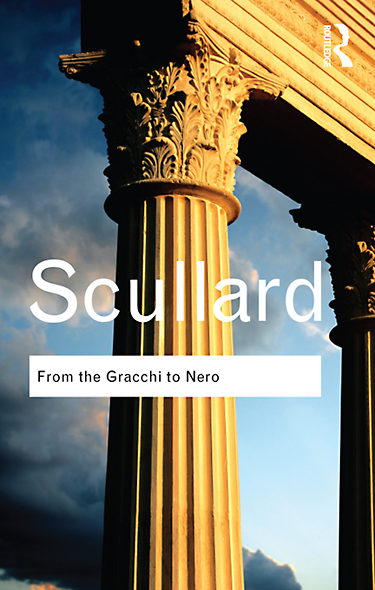From the Gracchi to Nero: A History of Rome from 133 B.C. to A.D. 68
Read From the Gracchi to Nero: A History of Rome from 133 B.C. to A.D. 68 Online
Authors: H. H. Scullard
Tags: #Humanities


From the Gracchi to Nero
‘Still the best introduction to Roman history’
Miriam Griffin, University of Oxford, UK
‘For a concise, factual narrative of the Roman world’s traumatic transformation from Republic to Empire, [it] remains unsurpassed. As a foundation for university and college courses, it is invaluable.’
Richard Talbert, University of North Carolina, Chapel Hill, USA
‘Without a rival as a guide to the intricacies of Republican politics.’
Greg Woolf, University of St. Andrews, UK
‘A classic textbook: clear, authoritative and balanced in its judgements … it has established itself as the fundamental modern work of reference for teachers, sixth-formers and university students … it is still the best and most reliable modern account of the period.’
Tim Cornell, University of Manchester, UK
‘This book is a modern classic. It provides a clear narrative of the two centuries from 133 B.C. to 68 A.D., but it is especially valuable for Scullard’s extensive footnotes which provide undergraduates with both the ancient sources and the most important scholarly contributions.’
Ronald Mellor, University of California at Los Angeles, USA

Routledge Classics contains the very best of Routledge publishing over the past century or so, books that have, by popular consent, become established as classics in their field. Drawing on a fantastic heritage of innovative writing published by Routledge and its associated imprints, this series makes available in attractive, affordable form some of the most important works of modern times.
For a complete list of titles visit
www.routledge.com/classics
H. H. Scullard
From the Gracchi to Nero
A history of Rome from 133 B.C. to A.D. 68
With a new foreword by Dominic Rathbone

London and New York
First published 1959 by Methuen & Co.
First published in Routledge Classics 2011
by Routledge
2 Park Square, Milton Park, Abingdon, Oxon OX14 4RN
Simultaneously published in the USA and Canada
by Routledge
270 Madison Avenue, New York, NY 10016
Routledge is an imprint of the Taylor & Francis Group, an informa business
This edition published in the Taylor & Francis e-Library, 2010.
To purchase your own copy of this or any of Taylor & Francis or Routledge’s collection of thousands of eBooks please go to
www.eBookstore.tandf.co.uk
.
© 1959, 1963, 1970, 1976, 1982 H. H. Scullard
Foreword © 2011 Dominic Rathbone
All rights reserved. No part of this book may be reprinted or reproduced or utilized in any form or by any electronic, mechanical, or other means, now known or hereafter invented, including photocopying and recording, or in any information storage or retrieval system, without permission in writing from the publishers.
British Library Cataloguing in Publication Data
A catalogue record for this book is available from the British Library
Library of Congress Cataloging in Publication Data
A catalog record for this book has been requested
ISBN 0-203-84478-5 Master e-book ISBN
ISBN10: 0–415–58488–4 (pbk)
ISBN10: 0–203–84478–5 (ebk)
ISBN13: 978–0–415–58488–3 (pbk)
ISBN13: 978–0–203–84478–6 (ebk)